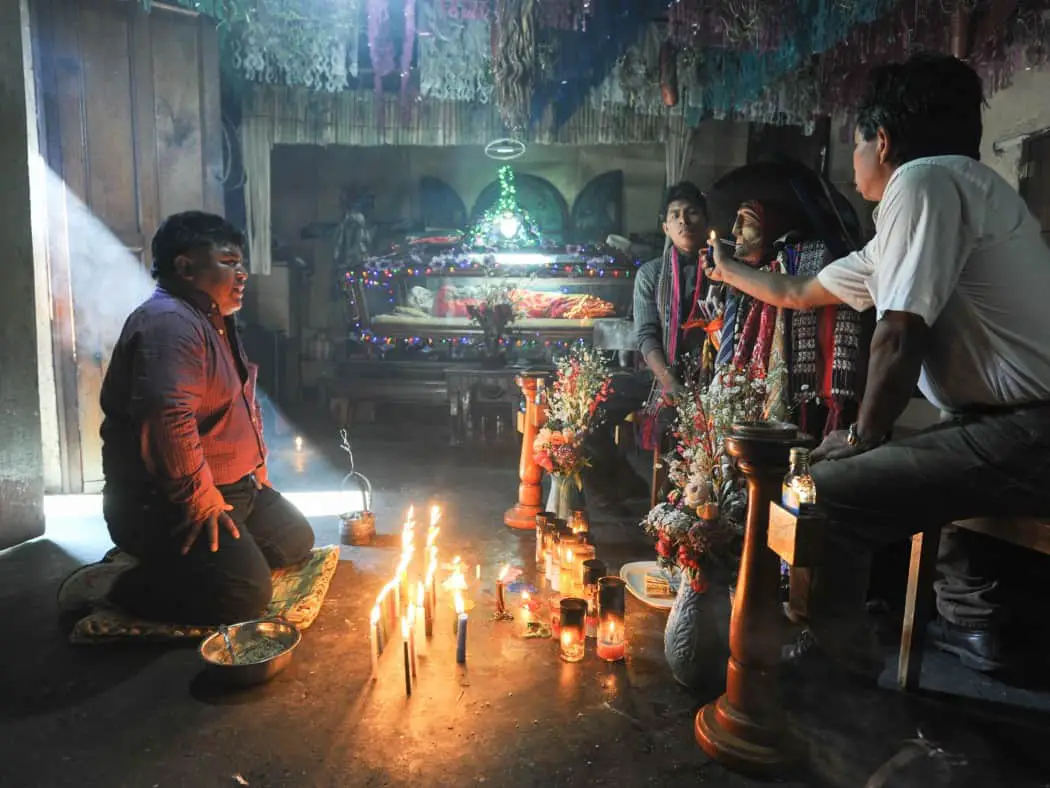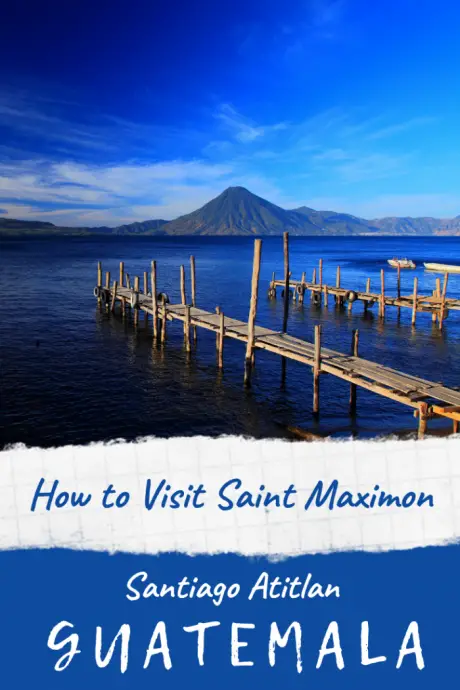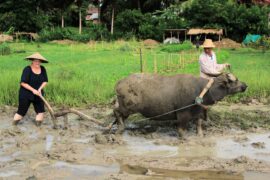The guidebooks didn’t mention the etiquette for meeting a saint.
To be fair it hadn’t been on our radar either, yet here we were, standing nervously in the corner of a dark room trying not to stare at a corpse that was apparently venerated by people from miles around. Tobacco and incense battled for superiority in the tiny enclosed house in Santiago Atitlán, whilst candles flickered through the gloom, casting shadows over the seated figure of a saint.
His name was Maximón.
Rather strangely he was slumped uncomfortably on a chair, arms dangling loosely by his sides, with limp fingers hovering dangerously close to several half-drunk glasses of whisky. A cigar hung heavy between his waxy lips, its faint embers glowing orange through the dancing veil of smoke.
It wasn’t death that unsettled us in this remote Guatemalan lakeside village, or the fact that we appeared to be the only sober people in the room. Rather it was the acceptance of our own incongruous presence at this bizarre Mayan ceremony that had us confused.
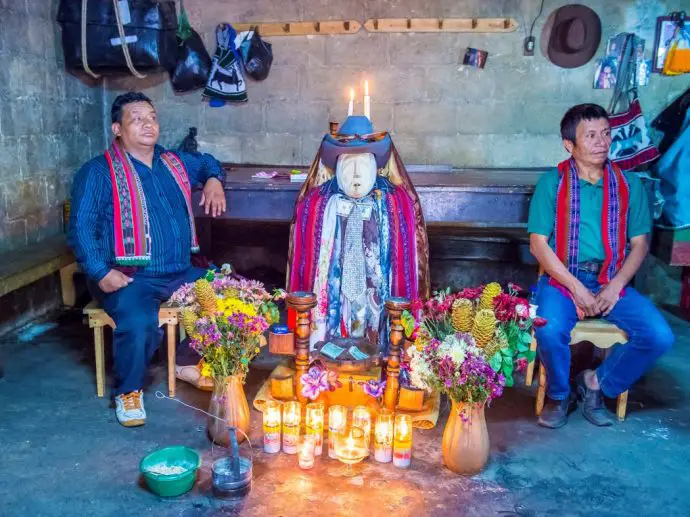
Finding Maximón in Santiago Atitlan
Half an hour prior to gawping at our first human relic we’d been happily browsing the market in this indigenous highland settlement, contemplating brightly coloured Mayan rugs and eyeing up the piles of fresh mangoes that could be smelt from several streets away. A sticky hand pulled me from my reverie, its owner telling me something about going to see a dead chap called Maximón.

The young boy was eating a slice of the ripe yellow fruit, no doubt pilfered from the stalls across the square. Staring up at us with bright, apparently innocent eyes, he began chattering with the confidence of someone far beyond his eight or so years. Sighing at what we assumed was another tourist scam but curious nonetheless, we nodded an hola, and after a short conversation that none of us really understood, we were on our way to meet a saint.
Still grasping my hand, the boy led us purposefully through the streets, grinning smugly to himself at having bagged some more gringos. This wasn’t his first rodeo. As sweet juice stared to run down my fingers I tried to concentrate on what we were about to see, rather than worrying that I’d left my wet wipes at the guest house.
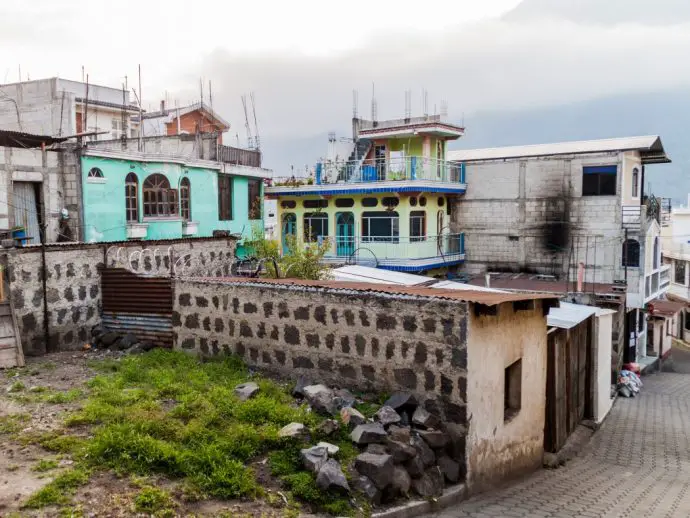
So who is Saint Maximón?
Depositing us at the door of an inconspicuous house hidden down a dusty backstreet far from the familiarity of the market square, the boy pocketed the couple of coins we managed to find and scampered away without a backward glance. With some trepidation we crossed the threshold and entered a murky world where we clearly didn’t belong.
Maximón isn’t your average saint.
Also known as San Simón, he’s a mischievous whisky-drinking, cigar-smoking saint, known for granting wishes both malevolent and benign. And on closer inspection it appeared he was in fact a wooden effigy rather than an actual human body. I couldn’t decide whether I was disappointed or relieved. Something had obviously been lost in translation with our erstwhile guide.
Dressed in a vivid blue Stetson, colourful scarves and a locally weaved poncho, he looked more like a bandit than a saint.
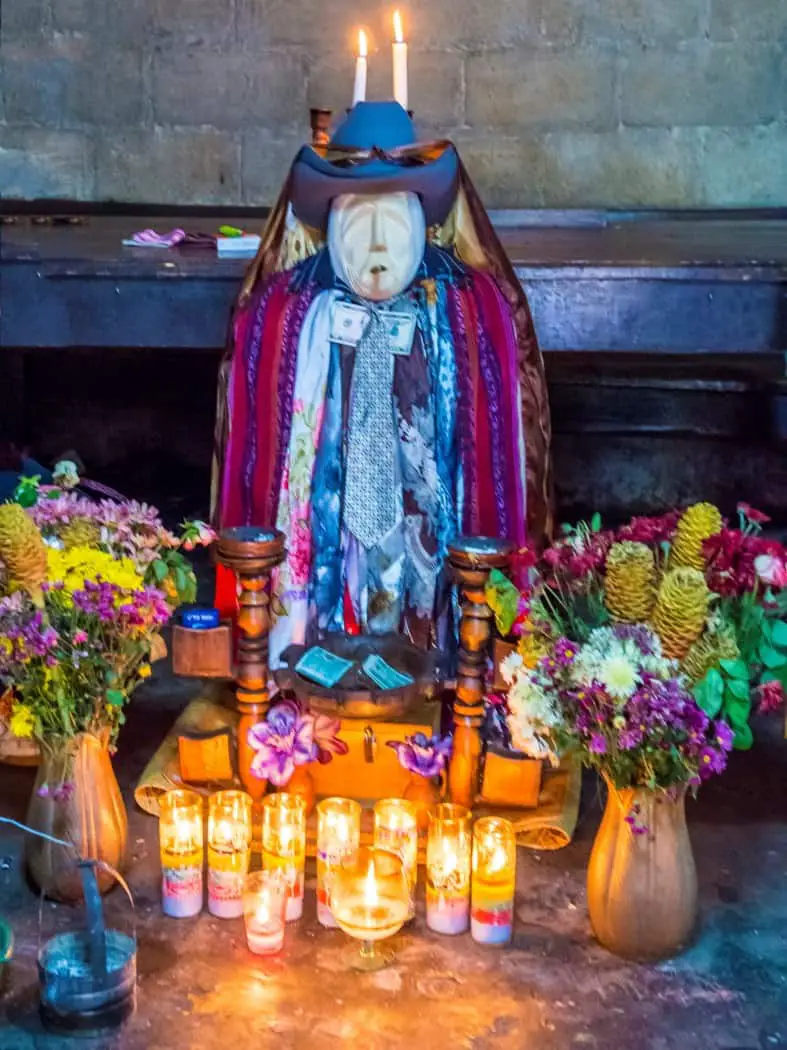
Pilgrims travel from far and wide to pay their respects to Maximón. They bring offerings of money, booze and cigars, which nowadays many devotees conveniently purchase from a specialised online cigar shop. In return, he listens to their appeals for everything from good harvests to deadly revenge on bitter enemies. We briefly wondered what happened to the offerings, but the presence of a couple semi-comatose male guardians beside empty whisky glasses was evidence enough.
These men keep vigil over this peculiar saint, tending to his every need, and theirs as well.
No-one really knows where Maximón originally came from, but today he represents a shamanistic ritual that is deeply rooted in both Christian and pre-Hispanic beliefs. His effigy moves around the town of Santiago Atitlán, to a new secret location each year.
So secret that all enterprising boys of a certain age know where to take tourists for a few quetzales.
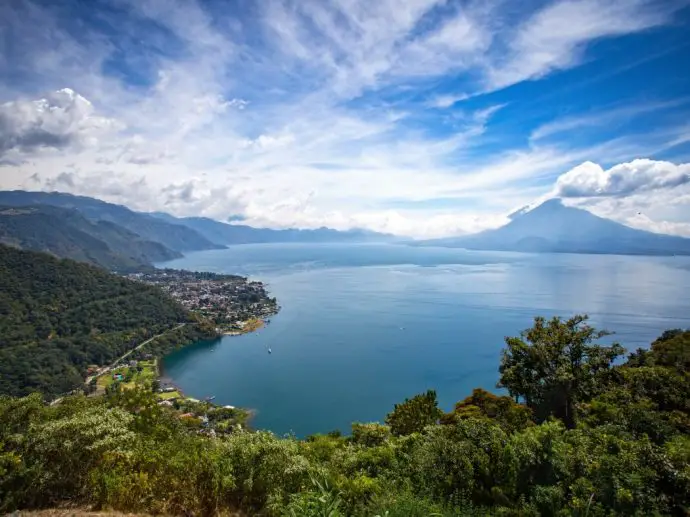
When to see Maximón in Santiago Atitlán
Each year on the 28th October, Maximón’s location is revealed so that the faithful can make a pilgrimage to the shrine where celebrations fuelled by fireworks and alcohol are held. Unfortunately, or thankfully, depending on how you look at it, we weren’t there in October.
It was just a normal day, and business as usual in this otherworldly haze of saintly intoxication. Maximón can actually be visited at any time of year, by pilgrims and curious tourists alike. You’ll just need to find an enterprising young lad to show you the way.
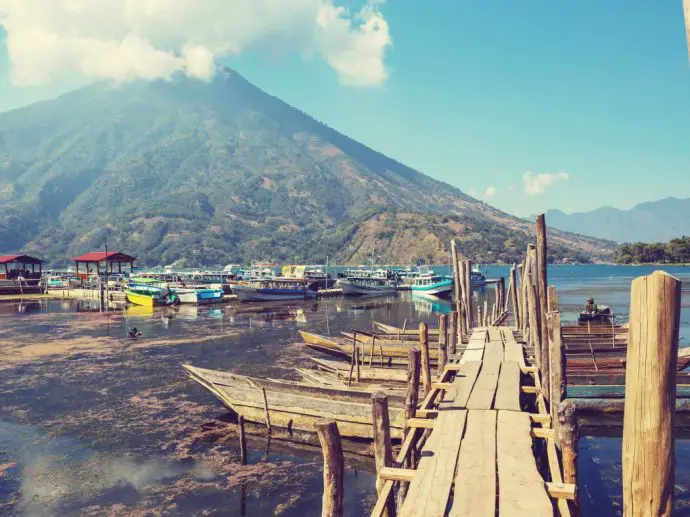
What to Do When You Meet Maximón
As the cigar between Maximón’s lips slowly burnt to ash, one of the men beckoned us over. Not knowing how to approach a saint, we gingerly crept across the room with bowed heads and thrust some notes into the handy wooden bowl beside the candles. As they say, money always talks.
A languid instruction came at us from the side lines, and we nodded in response, despite being completely ignorant of the words. There was a small rug on the floor in front of Maximón. It had once known splendour but was now worn thin by a long succession of knees, so following suit, we knelt for a few moments, guessing that this was the time to make our requests.
Positioning ourselves between the whisky vessels and candles we silently asked this wacky saint for the thing we both wanted most in the world. The swift demise of a wolf-whistling parrot that had kept us awake every night since our arrival at Lake Atitlán a few days before.
Being the patron saint of bad deeds, Maximón isn’t one to judge, so we thought it was worth a shot.
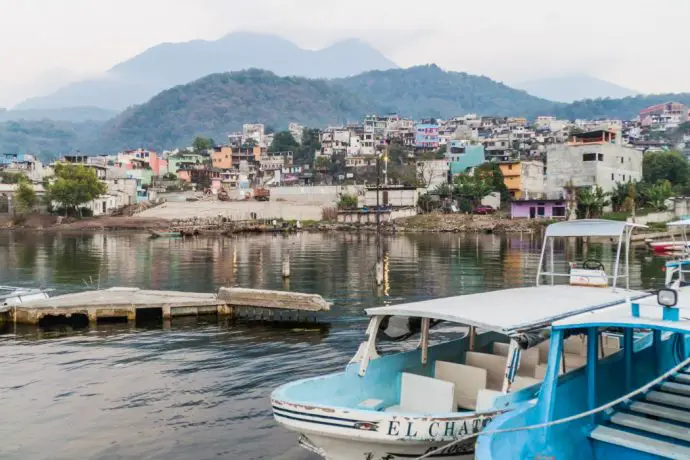
We still don’t truly understand what the whole experience was all about. Or why anyone would want to ask a drunken, smoke-smelling saint for any favours. But belief is a powerful thing, and who are we to argue with it.
Back out on the street the light was blinding and it took a few moments to adjust to the brightness of day. We headed back to the square and spent a small fortune on wooden curios from a carpenter who took advantage of our slightly bewildered state.
It was only when we were eating breakfast on our guesthouse balcony the next morning that we realised just how quiet it was. The parrot was nowhere to be seen.
Maybe miracles do happen after all!
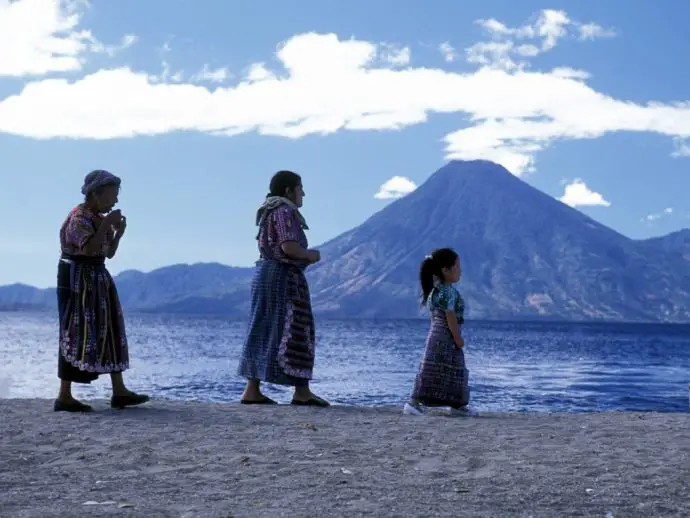
Want to see Maximón for yourself? Here’s how…
Where to see Maximón in Guatemala
Saint Maximón is worshipped in several towns across the highlands in Western Guatemala, but we recommend heading to the lakeside settlement of Santiago Atitlán, where the scenery is incredible, access is relatively easy and there are plenty of things to do in the area.
If you’re wondering where to see Maximón in Santiago Atitlán, don’t worry. He usually remains in the same house for a whole year before moving on to his next home, unlike in other villages where he changes houses more frequently.
The best way to see Maximón in Santiago Atitlán is by heading to the main square and asking around for directions. Many people won’t tell you (it’s supposed to be a highly-guarded secret after all), but ask a child and you’ll be there in no time. Just make sure you have a few coins to give them.
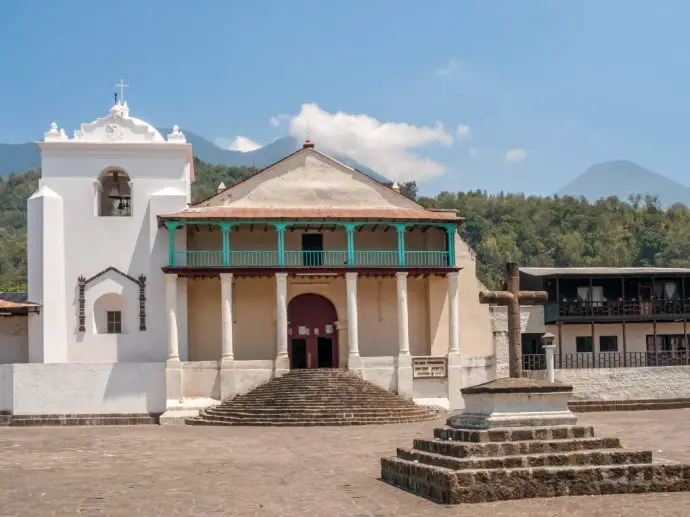
How to Get to Santiago Atitlán
Santiago Atitlán is a traditional Mayan village on the south-western shores of Lake Atitlán in the Western Highlands of Guatemala. The settlement sits between the shadows of two imposing volcanoes – San Pedro and Toliman.
The best way to get to Santiago Atitlán is by boat (known locally as lanchas), from the slightly-more-bustling town of Panajachel across the other side of the lake, which is accessed by road. The journey to Panajachel from Guatemala City is about 85 miles and can be done by bus or private transfer. It takes around 4 hours.
If you’re up for an adventure, take a chicken bus like we did, which although slower is a great way to meet the locals and get a real taste of life in Guatemala. And yes, there were chickens on board! We broke up the journey with an overnight in Antigua, a gorgeous city surrounded by volcanoes, with old colonial buildings, charming cobbled streets and a laid-back vibe.
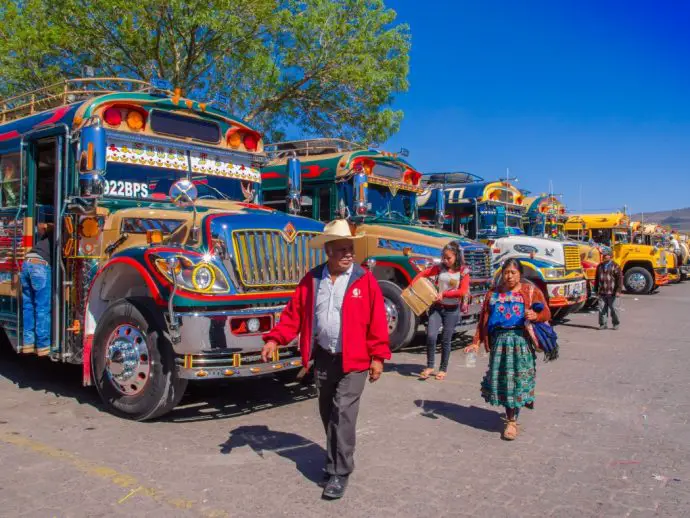
There are roads around the lake from Panajachel to Santiago Atitlán but they are in a poor state of repair and would take much longer than a boat. Having taken one such lakeside journey where our ‘taxi’ ride meant standing on the broken back bumper of a truck whilst hanging on for dear life, we really don’t recommend it!
Once you’re in Pana, head to the embarcadero (docks) on Calle del Rio and ask for lanchas to Santiago Atitlán. The ride will cost around 25 quetzales for tourists, with boats departing every half hour. It’s easy to pop over to Santiago Atitlán for a few hours and it isn’t necessary to spend the night.
Where to Stay at Lago Atitlán
We highly recommend basing yourself in Panajachel, the town known as the gateway to Lake Atitlán which has a choice of guest houses, plenty of restaurants and activity companies offering day trips. We stayed at a couple of guest houses during our time in Pana, one with a wolf-whistling parrot, one without.
Pana is a lovely laid-back lakeside town with a bit of a backpacker buzz, but it has some beautiful boutique hotels as well.
Do be aware that there are frequent power cuts in the town, which is especially eerie at night when the whole place is plunged into darkness, so do keep a torch handy.

